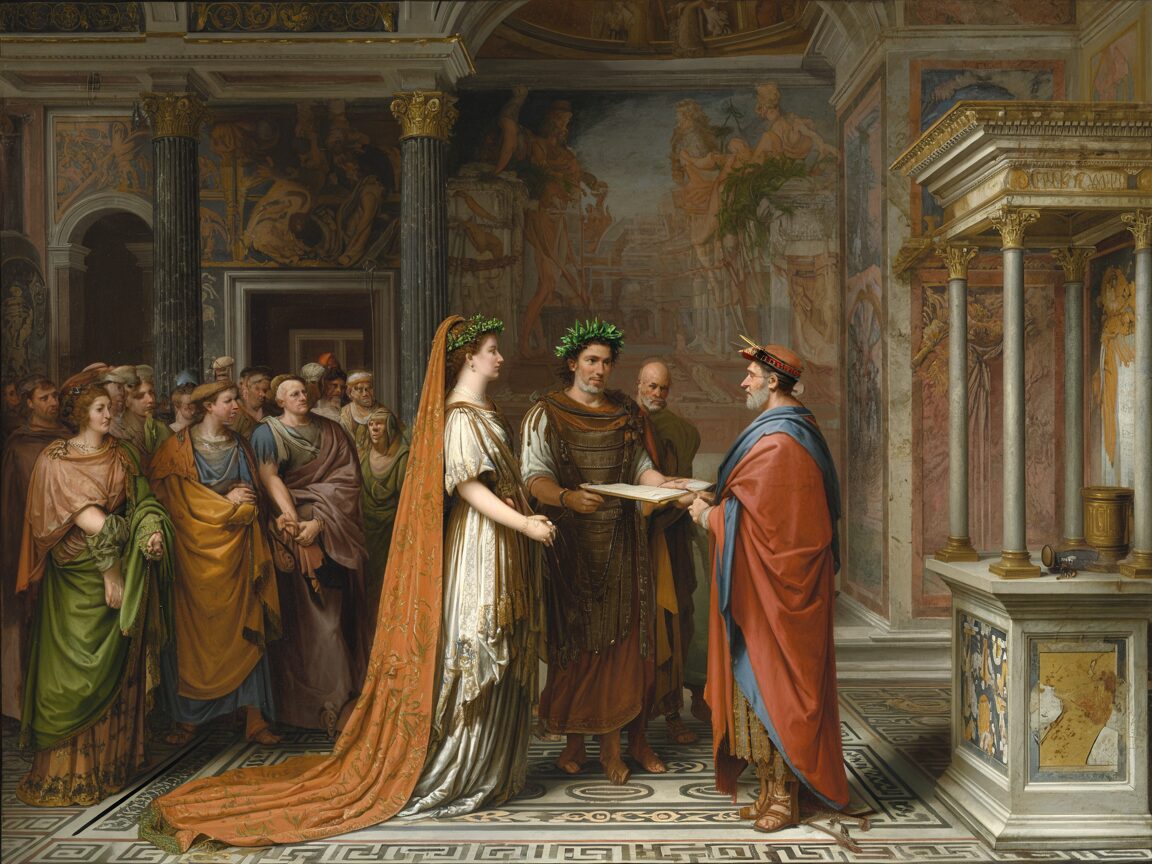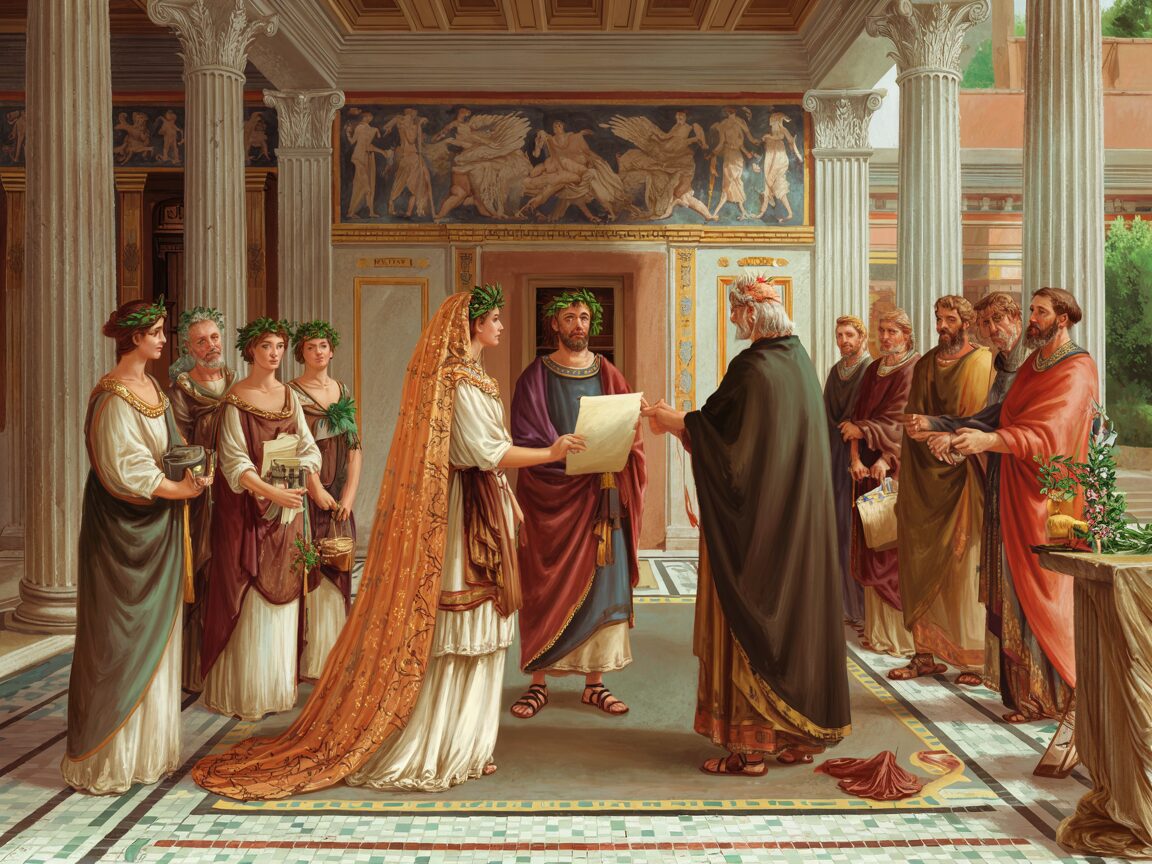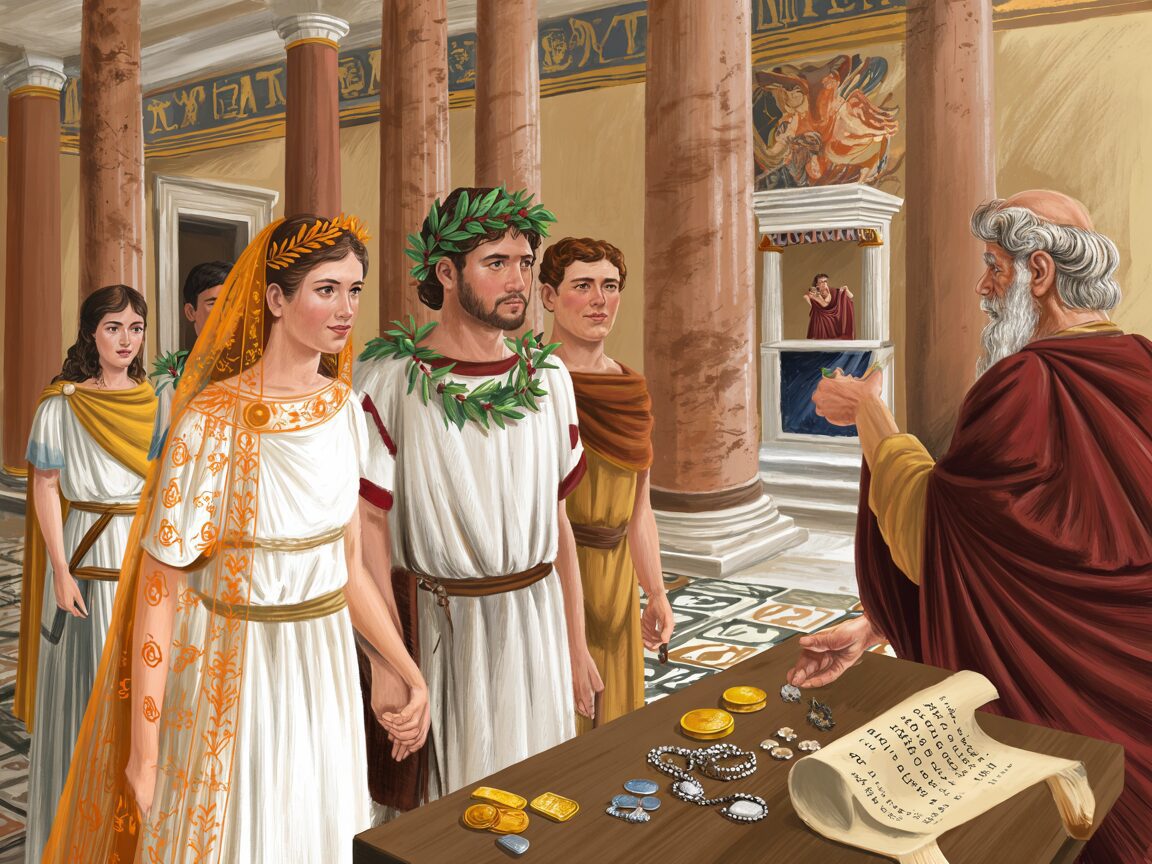Understanding marriage contracts and prenuptial agreements in Roman society offers valuable insights for 2025 readers curious about the origins of marital law. In ancient Rome, marriage was less about romance and more about formal agreements between families, often documented through detailed legal contracts. These arrangements protected dowries, secured family alliances, and established financial responsibilities.
Why should you care about these customs today? The principles behind Roman marriage contracts shaped many modern legal practices regarding marriage and property. Concepts like asset protection, dowry management, and formalized betrothal ceremonies have echoes in contemporary prenuptial agreements. In fact, Roman Law, which originated around 753 BCE, has played a crucial role in shaping modern legal systems.
This article unpacks how Roman marriage contracts operated within their social context and traces their influence on the evolution of marital laws worldwide. By exploring these ancient practices, such as understanding the lives of plebeians who were vital to the fabric of Roman society, you gain a clearer understanding of how historical frameworks continue to impact how marriages are legally structured in 2025.
Moreover, the philosophical underpinnings of these contracts were often influenced by Stoicism, which emphasized living in harmony with nature and using reason—principles that also found their way into the legal framework of marriage.
Lastly, it’s fascinating to note how Roman mythology has influenced modern culture, reflecting the societal norms and political aspirations of ancient Rome.
The history of Rome is a complex story shaped by many factors. One of the most interesting parts was the entertainment in Ancient Rome, which included gladiators, chariot races, and theaters. These activities were more than just fun; they had a significant impact on social relationships and political power.
Another important influence on Roman society was The Twelve Tables, a set of laws created between 451-450 BCE that aimed to organize the complicated legal practices of the time. This was a major development in ancient Roman law.
Agriculture also played a vital role in the growth of Rome’s economy. It wasn’t just about producing food; it was a key factor in Rome’s economic and social progress. You can learn more about this in our article on the role of agriculture in Roman economic growth.
The legal principles established during ancient Rome continue to influence modern law today. A prime example is the Corpus Juris Civilis], a comprehensive legal code commissioned by Emperor Justinian I in the 6th century AD that preserved ancient Roman legal ideas while also making them relevant to contemporary society.
For those who want to delve deeper into Roman culture, role-playing games like Second Life provide an immersive experience into the world of ancient Rome, allowing players to interact with its rich history in a one-of-a-kind way.

The Marriage Contract in Ancient Rome
The Roman marriage contract served as a formal legal document that bound two families together rather than just the individuals marrying. Its primary purpose was to establish clear terms regarding financial responsibilities, property rights, and social obligations. This contract was essential in protecting family wealth and ensuring alliances were honored.
Key elements of the Roman marriage contract
Key elements within the contract included:
- Dowry terms: The dowry (dos) was a crucial component, often consisting of money, land, or valuables transferred from the bride’s family to the groom or his family. It functioned as both a contribution to the new household and a form of security for the wife.
- Financial arrangements: Agreements detailed how assets would be managed during the marriage and what conditions applied in case of divorce or death.
- Property rights: Contracts often specified inheritance rights and control over property acquired during the marriage.
The betrothal ceremony and its significance
The betrothal ceremony marked the official start of this agreement. It involved a ceremonial exchange of gifts between families, symbolizing mutual commitment. A written agreement was drawn up and sealed with a kiss—called osculum, underscoring its binding nature under Roman law. This process, known as sponsalia, made the promise legally recognized even before the wedding day.
This structured approach ensured marriages were not only social contracts but also enforceable legal commitments with clearly defined economic expectations.
The broader impact of these marriages
Moreover, these marriages often facilitated strategic alliances that could influence various aspects of society including politics and commerce. For instance, the Roman roads, which were instrumental in maintaining and expanding the empire, also played a significant role in these alliances by ensuring effective transportation and communication between different regions.
Additionally, the wealth accumulated through these marriages could be utilized in various ways including investment in incredible Roman engineering feats that changed the world or funding artistic endeavors that reflected the rich art and culture in ancient Rome.

Customs and Traditions During Roman Weddings
Roman wedding customs were rich in symbolism, deeply rooted in tradition, and reflected the social values of the time. These weddings in ancient Rome were characterized by a series of rituals and practices that are still fascinating to study today.
The Bride’s Attire
The bride’s attire was one of the most visually significant elements during the ceremony. She wore a tunic recta, a simple, straight-cut dress representing modesty and purity. Draped over her head was an orange veil called the flammeum, which symbolized warmth, fertility, and protection from evil spirits. This bright veil distinguished the bride and marked her transition from maidenhood to married life.
The Role of Bridesmaids
Bridesmaids played an essential role in escorting the bride to the ceremony. Their presence was both practical and symbolic—they provided companionship, emotional support, and helped ward off any ill fortune that might befall the couple. These attendants also participated in various rituals that emphasized communal involvement in the marriage.
Other Customs Reinforcing Formality
Several other customs reinforced the formal nature of Roman weddings:
- The ceremony often began at night or early morning to ensure auspicious beginnings.
- The bride was carried over the threshold of her new home, symbolizing her entry into a new phase of life.
- A ceremonial sacrifice or offering to household gods (Lares) took place to bless the union. This aspect highlights how ancient Roman religion intertwined with their daily lives and significant events such as weddings.
- The groom wore a wreath of myrtle, associated with love and fidelity.
Such rituals underscored marriage as more than a personal contract—it was a socially significant event binding families and communities together. These traditions intertwined with legal frameworks like marriage contracts and prenuptial agreements, highlighting how deeply embedded these practices were in Roman society’s structure.
Broader Influence of Customs
The influence of such customs extended beyond personal lives into broader societal structures, much like how the Roman Army shaped the empire’s growth or how Roman architecture served as a testament to their power and cultural identity. Overall, these customs not only defined individual marriages but also played a crucial role in shaping societal norms and values across Rome.

Divorce and Legal Provisions Regarding Marriage in Ancient Rome
Divorce was relatively common and socially accepted, especially among the Roman upper classes. It functioned as a practical solution to dissolve unsuccessful marriages without severe social stigma. The ability to divorce reflected the contractual nature of Roman marriage, emphasizing legal and financial considerations over emotional bonds.
Procedures for Ending a Marriage
Roman divorce laws established clear procedures for ending a marriage. One critical aspect involved dowry return, which depended heavily on fault determination. If the wife was found at fault—such as through adultery—she typically lost rights to reclaim her dowry. Conversely, if the husband was the guilty party or if separation occurred by mutual consent, the dowry would often be returned to the wife’s family.
Adultery Laws and Gender Biases
The lex Julia laws introduced during Augustus’ reign significantly shaped marital conduct by penalizing adultery. The legislation imposed heavier punishments on adulterous wives compared to husbands, reflecting gender biases entrenched in Roman law. These laws reinforced patriarchal control within marriage, highlighting women’s vulnerability under legal scrutiny. This dynamic is further emphasized when considering the legal status of Roman women, which reveals a complex interplay of rights and restrictions that significantly influenced gender dynamics in ancient Rome.
Key Points of Roman Divorce Laws
Key points regarding Roman divorce laws include:
- Prevalence among elite classes: Divorce was a strategic tool rather than a last resort.
- Dowry protection linked to fault: Financial arrangements shifted based on who caused the marriage breakdown.
- Lex Julia’s impact: Adultery laws disproportionately affected wives, reinforcing gender inequality.
Balancing Flexibility and Boundaries
Roman divorce frameworks combined social flexibility with strict legal boundaries, emphasizing property rights and family honor over personal emotions. This historical context is crucial to understanding the broader societal implications of figures like Scipio Africanus, whose military achievements not only changed the course of history but also influenced social structures within Roman society.

Prenuptial Agreements: Origins and Evolution Through History
The history of prenuptial agreements extends back over 2,000 years, with significant roots in both ancient Rome and Greece. These early contracts were designed primarily for asset protection, securing dowries and safeguarding family wealth. Families used legally binding documents to outline financial responsibilities and ensure that property interests remained protected across generations.
Ancient Agreements: Rome and Greece
Key features of these ancient agreements included:
- Detailed terms governing dowries and inheritance
- Clauses protecting family assets from marital disputes
- Formalized exchanges that made contracts legally enforceable
The Jewish Ketubah: A Comparative Perspective
An important comparative example is the Jewish Ketubah, which functions similarly to a prenuptial agreement but stands out by explicitly granting women certain legal rights within marriage. Unlike many Roman contracts that often favored patriarchal control, the Ketubah provided protections for the wife, specifying maintenance obligations and outlining her financial security in case of divorce or widowhood.
“The Ketubah represents an early recognition of women’s rights in marital law, contrasting with the predominantly male-centered asset management seen in Roman prenuptial arrangements.”
Cultural Approaches to Marriage Contracts
This juxtaposition highlights how various cultures approached marriage contracts differently while addressing similar concerns: protecting family interests and defining the economic framework of marriage. The evolution of prenuptial agreements reflects shifting social values about property, gender roles, and legal accountability within unions—issues still central in modern marital law discourse.
For a deeper understanding of the cultural context surrounding these agreements, particularly in ancient Rome, resources like Men of Pompeii can provide valuable insights.
Social Implications of Marriage Contracts in Roman Society
Marriage contracts in ancient Rome served as tools to strengthen family alliances and uphold social class structures. These agreements prioritized the interests of families over personal relationships between spouses. The union was viewed less as a romantic partnership and more as a strategic alliance that could enhance wealth, influence, and political connections.
Key social implications included:
- Reinforcement of family alliances: Contracts ensured that marriages aligned with family goals, often linking powerful clans or consolidating wealth.
- Preservation of social hierarchy: Marriages between classes were regulated; only those with conubium rights could legally marry, preserving elite status. This regulation played a significant role in daily life in ancient Rome, where the experiences of different social classes varied greatly.
- Gender roles defined by law: Men typically held control over property and decision-making within the marriage. Women’s legal identity was often subsumed under their husband’s authority, reflecting the gender roles in family life that were enforced during this period.
- Property control and inheritance: Dowries remained crucial assets within these contracts, outlining precise terms for ownership and transfer. Women’s financial contributions were protected but usually managed by male guardians.
- Limited personal autonomy: Spouses had little say in the contractual terms, which were negotiated primarily by their families to safeguard economic and social interests.
These dynamics shaped how Romans understood marriage—not just as a private relationship but as a public institution deeply embedded in societal order. The contracts reflected broader Roman values regarding family loyalty, property rights, and gender expectations that influenced daily life and legal practices alike. Such values also extended to other facets of society, including the realm of entertainment where gladiators were seen as both heroes and victims within a complex social system, further illustrating the intricate interplay between personal lives and societal structures in Rome.
The influence of ancient Rome on Western civilization is profound and enduring. From its inception as a small city-state to its transformation into a vast empire, the legacy of Ancient Rome remains a cornerstone of modern society. This impact is evident in various aspects, including culture, governance, and innovations.
The Significance of the Roman Republic
The Roman Republic, existing from 509 to 27 BCE, marked a significant transition in governance from monarchy to a complex political structure. This system laid the foundation for modern democracies and established key principles of governance that resonate today, which is detailed in our exploration of the structure of power in the Roman Republic.
Understanding this transition is essential for grasping the complexities of Roman governance and its enduring impact on modern political structures. The overthrow of the last king of Rome around 509 BCE marked the birth of the Roman Republic, a pivotal moment in history that represents a shift from monarchical rule to a republican system.
The Impact of the Roman Empire
Spanning over a millennium, the rise and fall of the Roman Empire has left an indelible mark on the world, shaping politics, culture, and society in ways that continue to resonate today. However, the story of Rome is not merely one of conquest and expansion; it is also a tale of innovation, culture, and governance.
For those interested in delving deeper into this fascinating subject, we invite you to join us on a journey through ancient Rome, where we explore the rich history and lasting impact of this remarkable civilization.
Conclusion
The Marriage Contracts and Prenuptial Agreements in Roman Society Explained for 2025 Readers reveals how foundational legal frameworks from ancient Rome continue to shape modern marital practices and agreements. These early contracts were not just about personal unions but carefully crafted tools to manage property, social alliances, and family interests—principles that persist in today’s prenuptial agreements.
Consider these key takeaways when reflecting on your own relationships:
- Marriage contracts in Rome prioritized financial clarity and social stability.
- Dowry arrangements and asset protections remain central themes across centuries.
- Understanding historical contexts helps demystify modern legal practices around marriage.
When navigating your own commitments, these lessons from Roman society offer valuable insight into balancing emotional bonds with practical safeguards.
FAQs (Frequently Asked Questions)
What were marriage contracts and prenuptial agreements in ancient Roman society?
In ancient Rome, marriage contracts and prenuptial agreements were formal legal documents that outlined the financial arrangements, including dowry terms, between families. These contracts served to protect family interests, reinforce social alliances, and establish the legal framework for marital unions.
How did Roman marriage customs influence modern marital laws and prenuptial agreements?
Roman marriage contracts laid foundational principles such as dowry protection and asset management that have endured through history. These concepts evolved into modern prenuptial agreements, which continue to safeguard assets and clarify financial responsibilities within marriages today.
What role did citizenship and ‘conubium’ play in Roman marriages?
Citizenship and ‘conubium,’ the legal permission to marry, were crucial in shaping marital unions in ancient Rome. Only those with conubium could enter into lawful marriages, which affected social status and the legitimacy of offspring, thereby reinforcing social and legal frameworks governing marriage.
What were some traditional customs observed during Roman weddings?
Roman weddings featured symbolic customs such as the bride wearing a tunic recta and an orange bridal veil symbolizing purity and modesty. Bridesmaids played supportive roles by escorting the bride, while ceremonies included rituals like gift exchanges and written agreements sealed with a kiss to formalize the union.
How was divorce handled in ancient Roman society, especially regarding dowry and fault?
Divorce was relatively common among the upper classes in Rome and served as a means to dissolve unsuccessful marriages. Legal provisions dictated conditions for dowry return based on fault determination, with laws like lex Julia penalizing adultery—often disproportionately affecting wives—thus influencing marital stability and property rights.
What social implications did marriage contracts have on gender roles and family alliances in ancient Rome?
Marriage contracts reinforced family alliances and social class structures rather than focusing on personal relationships. They influenced gender roles by determining property control and inheritance rights within marriages, often limiting women’s autonomy while strengthening familial bonds across generations.

